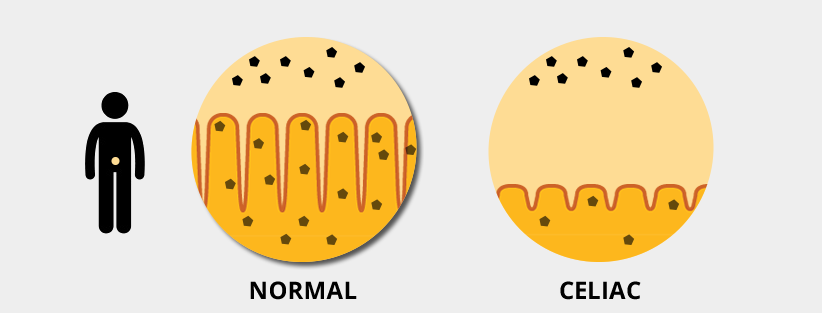 Gluten-free alternatives are fairly common these days but consumers should know how necessary they are and what benefits they give. Gluten are the naturally occurring proteins in wheat, barley and rye, and eating them can be life-threatening to people with celiac disease.
Gluten-free alternatives are fairly common these days but consumers should know how necessary they are and what benefits they give. Gluten are the naturally occurring proteins in wheat, barley and rye, and eating them can be life-threatening to people with celiac disease.
Celiac disease is a reaction to eating gluten, triggering an immune response in the small intestine. Over time, this reaction damages the small intestine’s lining and prevents it from absorbing some nutrients (malabsorption). The intestinal damage often causes diarrhea, fatigue, weight loss, bloating and anemia, and can lead to serious complications.
In children, malabsorption can affect growth and development, besides causing the symptoms seen in adults.
There’s no cure for celiac disease, but for most people, following a strict gluten-free diet can help manage symptoms and promote intestinal healing. Your FirstMed doctor can give you dietary advice.
Gluten refers to the proteins in cereal grains, such as the three mentioned above. It is found in the endosperm (a type of tissue produced in seeds that are ground to make flour) and nourishes plant embryos during germination. Later on, gluten affects the elasticity of dough, acting as a glue to hold the food together, which in turn affects the chewiness of baked products.
Gluten is a mixture of hundreds of distinct proteins within the same family, although it is primarily made up of two different classes of proteins: gliadin, which gives bread the ability to rise during baking, and glutenin, which is responsible for dough’s elasticity.
Not all grains contain gluten. Some examples of gluten-free grains are sorghum, millet, brown rice, buckwheat, wild rice, amaranth, quinoa, corn (polenta) and teff. Oats are also gluten-free but can be contaminated during processing, according to Lori Chong, a registered dietitian.
Is gluten bad?
Only for certain people, who are gluten-sensitive or gluten-intolerant, which means their bodies produce an abnormal immune response when breaking down gluten during digestion. In the United States, for instance, about 18 million Americans have gluten sensitivity, according to the National Foundation for Celiac Awareness.

The most well-known form of gluten intolerance is celiac disease, which affects one in every 141 people in the US, according to the US Department of Healthand Human Services. When someone with celiac disease consumes gluten, it triggers an immune response that damages their intestines, preventing them from absorbing vital nutrients.
The chronic gastrointestinal disorder called irritable bowel syndrome (IBS) is another condition that is affected by gluten. IBS affects 7 to 20 percent of adults in the US, according to a paper in the journal Gastroenterology & Hepatology. Chong says gluten grains are high in starches and sugars that can be easily fermented by intestinal bacteria. This can cause bloating, cramping and/or diarrhea.
Wheat allergy is a rare type of allergy that is marked by skin, respiratory or gastrointestinal reactions to wheat allergens, but is not necessarily caused by gluten. According to the American College of Allergy, Asthma and Immunology, 65 percent of children with a wheat allergy outgrow it by age 12.
Recently, scientists have become aware of another potential form of intolerance called non-celiac gluten sensitivity (NCGS). After consuming gluten, patients with gluten sensitivity may experience many celiac disease symptoms, such as diarrhea, fatigue and joint pain, but don’t appear to have damaged intestines. These symptoms can be due to poor digestion or a placebo effect.
According to a 2015 study, NCGS appears to be more common in females and young to middle-age adults. The study also questions what percentage of the population actually has NCGS, as many patients appear to diagnose and treat themselves with a gluten-free diet without consulting their doctor.
The effects of going gluten-free
In cases of gluten intolerance, doctors typically recommend a gluten-free diet. Patients must avoid eating such items as bread, beer, French fries, pasta, salad dressing, soy sauce and even some soups (unless otherwise marked as “gluten-free”). According to the US Food and Drug Administration, food products must contain less than 20 parts per million of gluten in order to be labeled gluten-free.
In recent years, many people without gluten intolerance have taken up gluten-free diets. In fact, according to the Mayo Clinic, 80 percent of people on gluten-free diets do not have a celiac disease diagnosis. Experts worry, however, that going on these diets without explicitly needing to could be detrimental to a person’s health, as gluten-free foods are often nutrient-deficient.
Dr. Refaat Hegazi, medical director for Abbott’s Adult Nutrition, says that going gluten-free can affect the body in many ways.
First, it can affect weight loss. Food restrictions associated with a gluten-free lifestyle can help some lose weight, especially when starches are replaced by healthier options, such as quinoa, which doesn’t contain gluten. “But it can also backfire – consumption of too much ‘healthier’ gluten-free food can cause weight gain,” said Hegazi. Food manufacturers often include additional fat or sugar to make gluten-free products tastier, increasing the product’s calorie count, and perhaps waistlines.

Second, going gluten-free can cause nutrient deficiencies. Many whole grains are rich in vitamins and minerals, such as vitamins B and D, iron and fiber. “Whether you need to be gluten-free as prescribed by a doctor, or you are choosing to cut back for personal reasons, a gluten-free diet is doable if followed carefully,” said Hegazi.
Third, some research suggests that a gluten-free diet may also affect cognitive function. Because gluten and carbs go hand-in-hand, going gluten-free can mean cutting carbs. One study, which has generated much discussion, suggests that elevated blood sugar levels may negatively impact brain structure and has been linked to cognitive decline and the development of Alzheimer’s disease.
“In addition, studies suggest that high carbohydrate intake is linked to elevated blood glucose levels and inflammation, as well. So, cutting gluten and carbs from your personal menu can support cognition as you age. However, more research must be done to truly understand the impact of gluten on your brain,” said Hegazi.
Fourth, going gluten-free can improve digestion, reducing bloating and diarrhea, among other symptoms, that are often associated with the sensitivity. Improved digestion associated with a gluten-free lifestyle may also relieve symptoms associated with other intestinal disorders such as lactose intolerance.




